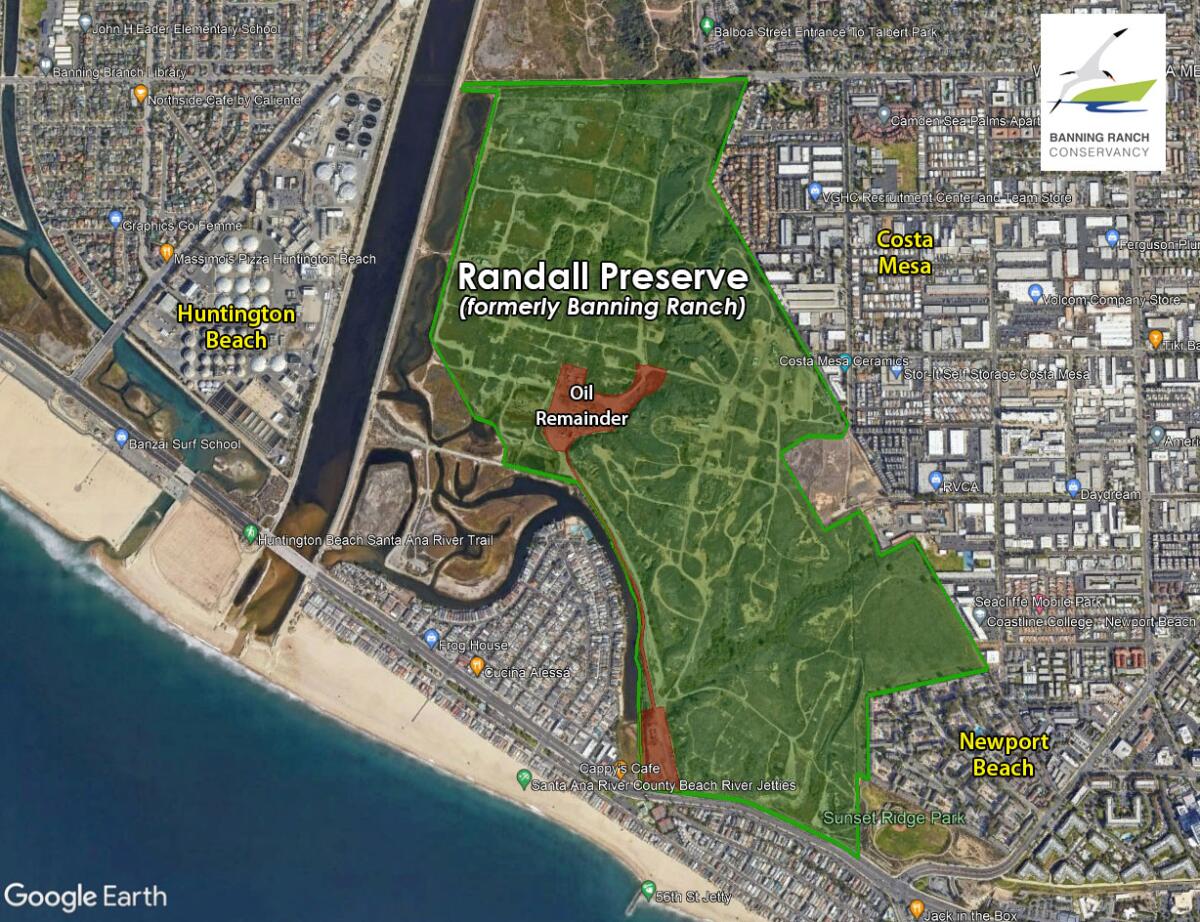With acquisition, Banning Ranch Conservancy looks ahead to restoration after remediation

- Share via
With the acquisition of the Banning Ranch property announced late last week, the area known as the Randall Preserve is officially complete and in public hands.
The 387-acre parcel is home to an estimated 100 acres of marshland, mudflats, riparian scrub and 67 acres of coastal sage scrub with critical habitats for endangered species like burrowing owls, fairy shrimp and peregrine falcons, according to a news release issued Monday by the Trust for Public Land, California Natural Resources Agency, Mountains Recreation and Conservation Authority and the Banning Ranch Conservancy.
The property has long been vied for by developers as the last remaining piece of undeveloped coastal property in Southern California. But through the efforts of conservationists, the land will now become a public park and preserve. It will be under the stewardship of the Mountains Recreation and Conservation Authority.
“Conservation takes a long time to happen,” said conservancy executive director Melanie Schlotterbeck in an interview Monday. “In this instance, it was 23 years to get to this day and that persistence, diligence and collaboration cannot be lost on this moment. There are a lot of players involved, whether that’s people who have been here for 23 years like [conservancy board president] Terry Welsh or some that came, did their good deed and moved on.”
Schlotterbeck said protection of Banning Ranch was only possible because of the property owners’ willingness to sell the land and because of the $50-million donation from Newport Beach philanthropists Frank and Joan Randall in 2019.

The land will now enter a remediation phase, which involves the removal of existing oil infrastructure by Aera Energy and its partners over the next two to three years. Schlotterbeck confirmed no public tax dollars will be spent on that work, as Aera will be financing it.
“As a California company, Aera holds the values of Californians: We strive to innovate, we celebrate productivity, and we advocate for the preservation of our beautiful state,” Erik Bartsch, president and chief executive of Aera Energy, said in a statement. “Today, we also celebrate the sale of our Newport Banning Ranch property, a historic moment that speaks to our commitment to the environment and people of California.
“We are proud that this land is now in conservation and will forever be open space to be enjoyed by millions of people, in perpetuity.”
In the meantime, the Banning Ranch Conservancy will not be resting on its laurels. Schlotterbeck said the conservancy recently established the PEER — partnerships, engagement, equity and inclusion, and restoration — program to cultivate a team of dedicated volunteers that will gain experience as restoration specialists by working on existing projects in neighboring public lands such as Costa Mesa’s Fairview Park and the Huntington Beach wetlands.
“By the time [Banning Ranch’s] ready for us, we’ll hopefully have several years of experience and a robust volunteer base,” Schlotterbeck said. “We do know that our landscapes impact one another. Plants, butterflies and coyotes don’t know human boundaries. What’s important is that the landscapes that are protected are held to a level of conservation so that all the neighboring lands benefit.”
She added that the conservancy will be working with the Mountains Recreation and Conservation Authority on a resource management plan and a coastal resilience plan to determine what activities might be suitable for the land and where.
“We hope to be and position ourselves to be a partner on the ground to MRCA when it comes to historical knowledge, connections with the community, relationships with elected officials and decision makers. We will still be engaged. It’s just no longer a fight,” Schlotterbeck said, adding that they were celebrating now but would roll up their sleeves to do the work next year.
“We’re in collaboration mode,” she said.
All the latest on Orange County from Orange County.
Get our free TimesOC newsletter.
You may occasionally receive promotional content from the Daily Pilot.




